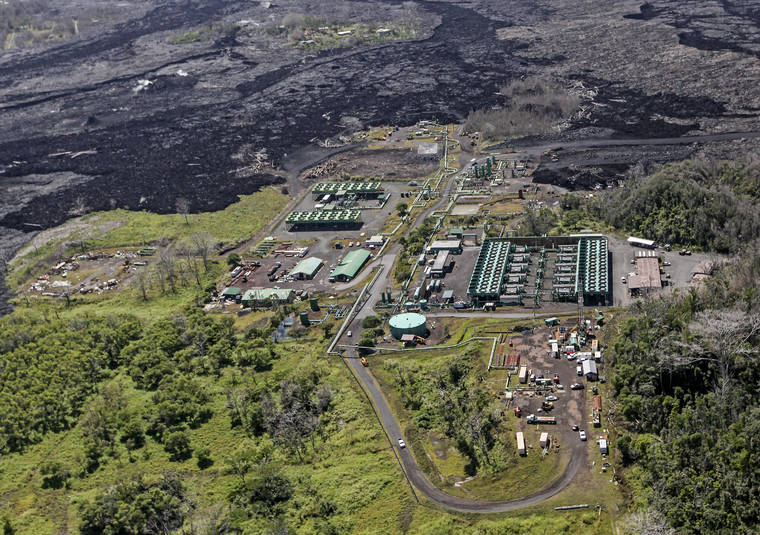Puna Geothermal Venture is expecting to return to operation by the end of this year and hopes to sell electricity in early 2020.
The state’s only geothermal power plant was isolated by lava during the 2018 eruption of Kilauea volcano, when lava destroyed a substation and covered a few geothermal wells, as well as cut off road access to the plant. It was otherwise spared significant damage in the eruption that began May 3, 2018, in lower Puna.
“The restart and reconstruction efforts of Puna are on schedule, and we expect our refurbishment activities will be completed by the end of the year, enabling us to deliver energy from the plant on the temporary lines that help support the power plant,” said Isaac Angel, CEO of PGV parent company Ormat Technologies, during a 2019 third-quarter earnings call in November. “We expect to be able to sell electricity produced at Puna as soon as the relevant permits required from the local authorities for the operation of the substation and transmission network pathways being undertaken by our partners at Hawaii Electric Light Company are received. These are expected by the end of Q1 2020.”
Mike Kaleikini, senior director, Hawaii affairs, said in a phone call Tuesday that returning to operation means having the ability to generate electricity and transport it to the HELCO grid.
This is the “test period, and then in the future, when the substation is built and the transmission lines (are built), then we anticipate being able to sell power to HELCO.”
Although the timeline depends on a number of factors, Kaleikini said “we’re looking for sure next year. The earlier the better,” although permitting can be a challenge.
According to Kaleikini, PGV received a grading permit which allowed the company to build an access road and do ground work for a new electrical substation but is going through the county permitting process for a building permit for the substation.
While PGV has a service connection that would allow the plant to export some power, the plant can’t return to full capacity until the substation is built, he said.
Kaleikini said PGV has so far restored several geothermal wells and repaired several electrical generating units.
Of PGV’s 11 geothermal wells, three were covered during the eruption, along with two groundwater wells, Kaleikini said. One of the covered wells has been uncovered.
The geothermal plant also drilled one new water well and is almost done with a second, backup water well, and it repaired two injection wells and one production well that were not covered by lava.
PGV began drilling a new production well in October, and Kaleikini said that well is expected to be completed some time in the first quarter of 2020.
According to a PowerPoint presentation that accompanied the earnings call, expected capital expenditures for well repairs and new drilling are expected to cost between $30 million and $50 million.
Ormat, however, expects proceeds from Control of Wells insurance to recover part of this investment.
“We maintained coverage for property and business interruptions in Hawaii provided by a consortium of insurers,” Angel said during the November earnings call. “All of the insurers have now started paying the costs to rebuild the damaged power plant equipment. However, certain insurers rejected our claim for business interruption coverage, and we have filed a lawsuit against those insurers. These lawsuits will not impact our plans for restarting the Puna facility.”
As of Sept. 30, the total claim for losses is $56.7 million, and Ormat has received $21.2 million, according to the presentation.
A docket from Hawaii Electric Light Co. — with the application for the construction of overhead transmission lines that will reconnect PGV to the HELCO grid — was suspended by the state Public Utilities Commission in August, pending additional information regarding project permits and a renegotiated power purchase agreement between the two companies.
HELCO was in negotiations with PGV regarding a possible amended and restated power purchase agreement that would, among other things, de-link the cost of power from the price of oil.
Kaleikini said the power purchase agreement between HELCO and PGV is still under negotiation.
“We are hopeful the suspended docket will be reopened by the end of the year … ,” he said.
Email Stephanie Salmons at ssalmons@hawaiitribune-herald.com.






